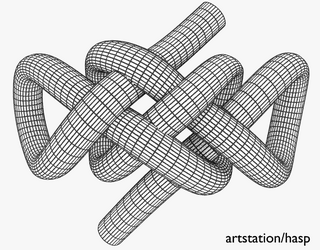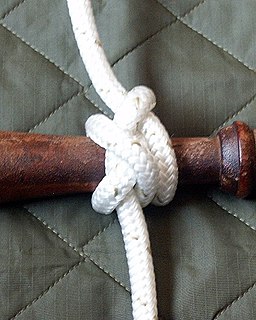 W
WAshley's bend is a knot used to securely join the ends of two ropes together. It is similar to several related bend knots which consist of two interlocking overhand knots, and in particular the alpine butterfly bend. These related bends differ by the way the two constituent overhand knots are interlocked.
 W
WAshley's stopper knot, also known as the oysterman's stopper, is a knot developed by Clifford W. Ashley around 1910. It makes a well-balanced trefoil-faced stopper at the end of the rope, giving greater resistance to pulling through an opening than other common stoppers. Essentially, the knot is a common overhand noose, but with the end of the rope passing through the noose eye, which closes upon it. It may be multiplied to form a larger knot with more than three bights appearing around the knot. It is the result of implementing a double wall knot in one strand.
 W
WA beer knot is a bend used to join tubular webbing. Its most common application is in constructing slings used in rock climbing. Compared with the water knot, it has the advantages of a higher strength, smaller profile, and a cleaner appearance due to the lack of free-hanging tails. However, the beer knot can be more difficult to tie than the water knot, and one of the tails is hidden from view, making safety checks for adequate tail length more difficult.
 W
WThe boa knot is a modern binding knot invented by weaver Peter Collingwood in 1996. His intention was to develop a knot that would hold well when the constricted object was cut close to the winds of the knot.
 W
WThe boom hitch is a type of knot. It is a rather robust and secure method of attaching a line, or rope to a fixed object like a pipe, post, or sail boom.
 W
WThe butterfly loop, also known as lineman's loop, butterfly knot, alpine butterfly knot and lineman's rider, is a knot used to form a fixed loop in the middle of a rope. Tied in the bight, it can be made in a rope without access to either of the ends; this is a distinct advantage when working with long climbing ropes. The butterfly loop is an excellent mid-line rigging knot; it handles multi-directional loading well and has a symmetrical shape that makes it easy to inspect. In a climbing context it is also useful for traverse lines, some anchors, shortening rope slings, and for isolating damaged sections of rope.
 W
WThe diamond hitch is a lashing technique used mainly in the field of equine packing, to secure a set of objects, for instance a pair of pack-bags, pack-boxes or other gear onto a base, for instance a pack saddle frame, in which case it requires the use of a lash cinch. In the general sense it requires the base to be equipped with at least two points of anchorage, and a rope which is used to lash the object down onto the base. There are two types of Diamond Hitches, a single, shown here, and a double diamond hitch which is not shown.
 W
WThe farmer's loop is a knot which forms a fixed loop. As a midline loop knot made with a bight, it is related to several other similar knots, including the alpine butterfly knot and artillery loop.
 W
WThe Farrimond friction hitch is a quick release adjustable friction hitch for use on lines under tension. It is useful when the length of a line will need to be periodically adjusted in order to maintain or adjust tension whilst remaining quick and easy to untie; such as when hanging the ridge line for a Basha. It can be used in very effective conjunction with the Siberian hitch for this purpose. It can also be used as a mooring knot.
 W
WA Prusik is a friction hitch or knot used to attach a loop of cord around a rope, applied in climbing, canyoneering, mountaineering, caving, rope rescue, ziplining, and by arborists. The term Prusik is a name for both the loops of cord used to tie the hitch and the hitch itself, and the verb is "to prusik". More casually, the term is used for any friction hitch or device that can grab a rope. Due to the pronunciation, the word is often misspelled Prussik, Prussick, or Prussic.
 W
WThe simple Simon under bend is a knot belonging to the category bend. It was invented by Harry Asher. It is more secure than the similar simple Simon over. The difference is just which of the green ends in the image below is the standing end.
 W
WThe snuggle hitch is a modification of the clove hitch, and is stronger and more secure. Owen K. Nuttall of the International Guild of Knot Tyers came up with this unique hitch, and it was first documented in the Guild's Knotting Matters magazine issue of January, 1987. Generally, hitches are used to attach a line to another rope or spar, pole, etc., and are usually temporary. Thus, they should be relatively easy to untie.
 W
WThe triple fisherman's knot is a bend knot, used to join two ends of rope together. It is an extension of the double fisherman's knot and is recommended for tying slippery, stiff ultra-high-molecular-weight polyethylene (UHMWPE) and aramid cored ropes.